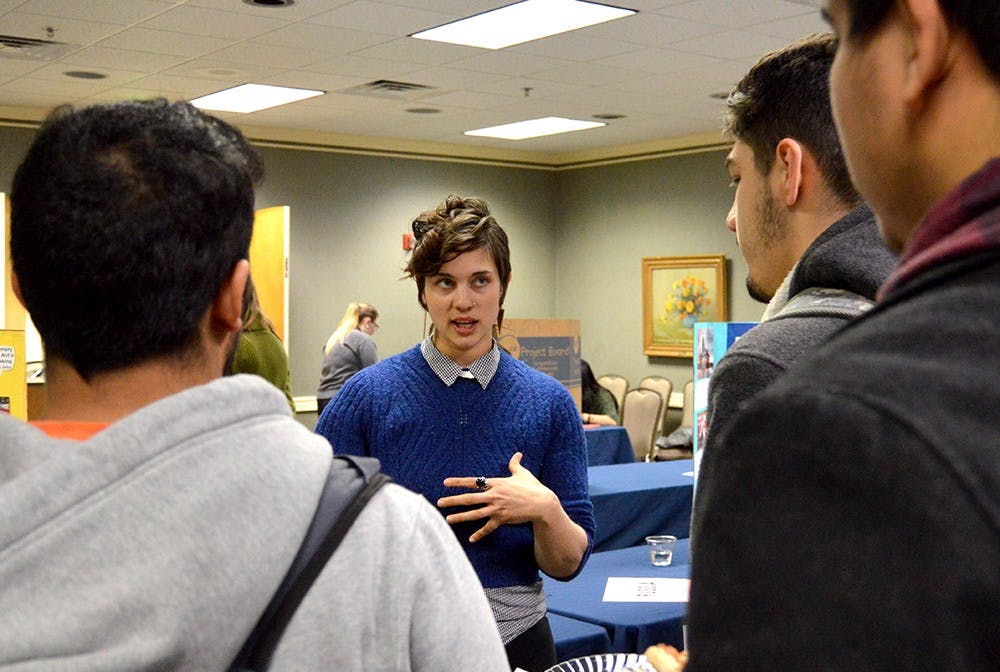During an interactive look at human trafficking, students with paper “passports” walked around the room and visited “countries” where victims of human trafficking may have traveled on their journeys.
Lives of victims were condensed to a few sentences on strips of paper.
One strip told the story of two young boys traveling from Egypt to escape the destruction.
Another spoke of a poor girl from Thailand who was sold to a brothel.
Yet another was a boy from Brazil who was almost sold as a child prostitute to a tourist during the World Cup, but escaped.
Jennifer Thuma, victims advocate at the Indiana attorney general’s office, led the discussion in a talk called “The Hidden Reality: An Interactive Program on Human Trafficking” at 6 p.m. Tuesday in the East and West Staterooms of the Indiana Memorial Union.
“Victims are everywhere, in every country,” Thuma said. “What I tried to bring to you was something very real.”
The stories students traced were based on real people, but the names were changed for privacy.
The display was the result of a partnership between the Indiana attorney general’s office, IU Student Association, IU’s United Nations Association and the Middle Way House.
“Sometimes it’s hard to engage with an audience on a topic this serious,” said Katelyn Lipa, a crisis intervention service coordinator at the Middle Way House.
An interactive display allows people to see it unfold in a more personal way, Lipa said.
Around the room, tables were set up with information about countries commonly involved in the human trafficking industry. Brazil and Russia are countries with the highest number of victims.
Under the wide umbrella of human trafficking are many different types, Thuma said. The event focused on three: sex trafficking, bonded labor and child labor.
Thuma described bonded labor as a situation in which an individual with a debt attempts to pay off that debt by working, but the interest rates in the host country make this impossible.
As a result, the individual is forced to continue working.
The cause of this is simple, Thuma said.
“That’s the name of the game – money,” Thuma said. “Human trafficking is the second-fastest-growing criminal industry in the world.”
It produces about $150 billion per year, according to the Indiana Protection for Abused and Trafficked Humans task force.
Another country with high rates of exporting victims of human trafficking is the United States.
“In the U.S., about 80 percent of trafficking victims were born here,” Thuma said.
It even happens in Indiana, Thuma said. IPATH reported that more than 100 tips of human trafficking were called in during 2014 alone.
One of the most successful tactics traffickers use to entice poor victims is the promise of jobs.
Children and teens who have no better option or who need to support their family may feel they have no other choice, Thuma said.
Unlike drug smuggling, which leaves physical evidence, human trafficking is harder to trace.
“It’s not as easy to see a trafficking victim who might be right in front of your eyes,” Thuma said.
Some people find it hard to believe that victims would continue to live in horrible conditions in which they work for almost nothing and are continually threatened or abused.
However, the average age of a trafficking victim is 12 years old, Thuma said.
“Once someone has been victimized as a traffic victim, that can go on for years,” Thuma said.
If someone has been a victim since childhood, they may not know of any other course of life, Thuma said.
“We believe that those are victims who need help,” Thuma said. “We’re one big world and whatever we do impacts someone else. There’s a lot of hope, I think, that survivors can give us.”






